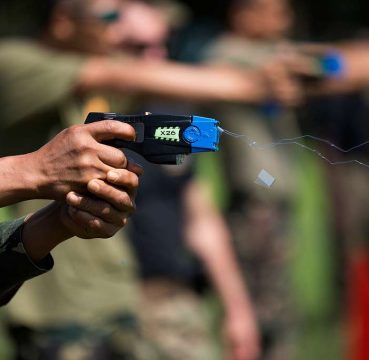I’ve always wondered why stun guns are called guns when they don’t really look, much less function, like any gun. A Taser device on the other hand typically looks and handles like a handgun and fires two prongs from a short distance, but I don’t think I’ve ever heard of anyone referring to it as a stun gun. So is there really a comparison of stun gun vs taser?
Stun Gun Vs Taser Non-lethal Purpose
Yes, both deliver non-lethal, super-high voltage electric shock to incapacitate a target, the only thing seemingly different between each platform being their method of delivering an electric shock. But would either be enough for self-defense?
Read on if you want to know more.
Table Of Contents
- Stun Gun Vs Taser Non-lethal Purpose
- How Tasers & Stun Gun Shock Weapons Work
- The Stun Gun
- The Taser
- Differences Between a Stun Gun vs Taser
- Are Taser Guns Legal?
- Stun Gun vs Taser Pricing
- Our Top Stun Gun Pick
- Taser Gun Pricing
- Our Top Pick For Taser Gun
- Stun Gun vs Taser – Recommendation
- Stun Gun vs Taser – Conclusion
- Recommended Reading
How Tasers & Stun Gun Shock Weapons Work
We often see the words “volts”and “amps” when we look at any electronic device manual.
What is a Volt?
The volt as a unit of measurement used in electronics is a pretty tricky concept to grasp, especially for people who have no background in electronics. I know I’ve had a bit of an issue with it in high school. To spare everyone the difficulty, let’s do an analogy.
Volt Understanding Analogy
Imagine a railway track between two points A and B. At point A, there are an infinite number of rail carts and a worker is tasked to push them from point A to point B until he gets tired, at which point in time he will have to be replaced by another worker who will continue pushing the carts.
The job requires that carts keep moving from A to B, each time hitting a big steel plate positioned in the middle of the track. There’s also a wheel stop somewhere on the track, if the boss wants whoever’s working to stop pushing carts down the track all he needs to do is activate the wheel stop.
How the Shock Device Works
Applying this very oversimplified analogy to how an electric shock device works, the railway is the circuit. The wheel stop is the on/off switch controlled by the boss who is the person controlling the electric shock device. The worker who pushes the cart is the battery, point A is the negative terminal and point B is the positive terminal on the device.
The frequency at which the rail carts are being pushed is the amperage (work done per unit time, measured in amperes). The rail cart that does all the work, for now, we’ll call the “coulomb” and the energy that the worker exerts, for now, we’ll refer to as “joules”.
And finally, the steel plate is the task’s objective, i.e. the target of the electric shock.
Volt Defined
Volt, as a unit of measurement, is defined as joules (energy) per coulomb (cart). In the analogy above, a battery (worker) is required to push the cart to hit the steel plate (the target) between points A and B (the two prongs on the device). When the boss (the person holding the device) disables the wheel stop (pushes the switch), assuming everything is in order, work (applying voltage to the target) is done.
On average, the human body can generate anywhere from 10 to 100 millivolts.
Our Nervous System Simplified
The way our nervous system works is neurons, or the nerve cells that carry electrical impulses, communicate with each other by sending signals, moving those across the synapses (gaps between the neurons) using chemicals known as neurotransmitters.
Signals are directed from the brain to the body via the spine. For instance, if you burn your finger, neurons fire electric signals to your brain which interprets the pain as a burning sensation.
It is important to note that in any electronic control device (ECD), it isn’t so much the voltage that matters but the current (amperage). Voltage only gives the push such that a specific device would be effective enough to go through clothing, but it’s the frequency at which the voltage is delivered that results in incapacitation.
Voltage vs Amps
To put things in better perspective, a 110v wall outlet that can deliver many amperes of current indefinitely will result in someone being burned to a toast. A 50,000v Taser device can only deliver around ~4 milliamps (only four-hundredths of an ampere) of electric current for a few seconds. Even with its high voltage, the infinitesimal amperage will not kill the target.
The Stun Gun
In 1745, a Dutch scientist named Pieter van Musschenbroek and a German cleric named Ewald Georg von Kleist invented a static electricity storage device called the Leyden jar.
Named after the city in the Netherlands where the Dutch inventor originated, the Leyden jar works a lot like modern-day capacitors, the main difference between the two being the latter had to release stored electricity quickly.
On a glass globe was a large wool pad that would have to be spun quickly to store a static electrical charge inside a connected Leyden jar. The person handling the jar had to be careful not to electrocute themselves.
Accidental Origin of Stun Gun
Pieter van Musschenbroek discovered that his invention can be used to electrocute an individual when he accidentally shocked himself with it. He described the sensation as being struck by lightning — it was so painful he thought it would kill him. It left his body shaking afterward.
In 1780, an Italian philosopher, physicist, biologist, and physician, Luigi Galvani, started a series of experiments. He found that the electric current from the same Leiden jar could cause contractions in dead animals when applied directly to muscle or nerve.
Battery Invented
Two decades later, the first modern-day battery was invented by another Italian physicist, Alessandro Volta (the unit of measurement mentioned above, energy per coulomb in “volt”, was named after him).
This battery was eventually used in cattle prods — hand-held club-like devices used by cattlemen which utilize electric shock to deliver massive amounts of electricity just painful enough to shock a cow’s rear end to get it to walk into a chute.
Stun Gloves
In 1933, a Cuban inventor by the name of Cirilo Diaz came up with an electric glove that uses a half-pound battery worn on the belt, all wires connecting it to the glove concealed beneath clothing. These “stun gloves” could deliver up to 1,500 volts and be intended for Cuban police forces to quell riots.
To this day, electric shock devices similar to cattle prods are still being used. The smaller versions are generally referred to as stun guns.
The Taser
In the early 1960s, race riots and anti-war protests (as a result of Americans being torn apart over the Vietnam war) were very common in the US and the police were still using cattle prods. President Johnson ordered the development of a more effective non-lethal weapon to subdue protesters.
History of the Taser
It was around this time that an American nuclear physicist, Jack Cover, started developing the Taser device after reading in the news about a man who survived being immobilized for several hours by a fallen power line.
Jack studied bioelectricity and learned that there are trillions of electrical impulses moving through nerve fibers back and forth between the brain and all sensors in the body.
He then made calculations and come up with his first crudely designed hand tool made from ordinary household items (bicycle parts, plastic tubing, etc.) to come up with the first prototype.
Just Enough Voltage
For the device to work properly, it has to deliver just enough voltage and current enough to make muscles contract but not enough to damage the body. To be portable, it should use electricity stored in a battery, and to make it effective at relatively longer, safer distances, it had to deliver an electric shock via two dart-like projectiles propelled by gunpowder charges.
As soon as both projectiles hit the target, an electrical circuit is formed which delivers a shock that disables the target’s body.
He completed a prototype electroshock weapon in 1970 and named it after a novel he read as a child which inspired him decades ago to come up with the same weapon the novel’s protagonist, Tom Swift, used — Taser, an acronym for Thomas A. Swift Electric Rifle (though it’s not really a rifle and Tom Swift didn’t have a middle initial).
What Was the First Taser Used On?
The first test subject was a buffalo from a local animal park. Jack was able to take it down using his prototype Taser. It immediately got back to whatever it was doing as soon as the weapon stopped cycling.
Then he tested it on himself (by making his sons shoot him) and it worked. His sons also volunteered to be part of the test by subjective themselves to the same electric shock.
First Taser Patent
In 1974, Jack Cover’s Taser TF1 was patented and production began that year. But shortly after, the Bureau of Alcohol, Tobacco, Firearms and Explosives (ATFE) classified the TF1 as a firearm due to the gunpowder required to launch the wired dual-dart projectiles, making it unavailable to the civilian market and discouraging police and military sales, which led to low sales and ultimately resulted in the demise of the product.
Fast forward to 1993, two brothers, Tom and Rick Smith, were looking to develop an alternative method of self-defense after their high school friends were gunned down in a road rage incident. Having learned of the Taser TF1, they implored the guidance of Jack Cover.
The trio eventually designed and developed a newer version, the Air Taser 34000.
Is a Taser a Firearm?
Unlike the TF1, ATFE couldn’t classify the Air Taser 34000 as a firearm because it didn’t need gunpowder to propel its dual projectiles. Instead, it only used compressed air.
They established a new company called Air Taser Inc. and started selling the new product in 1994, launched in partnership with The Sharper Image, a company that sells advanced consumer electronic devices.
Five years after, Air Taser Inc. had its corporate name changed to Taser International. A year after, the Taser M26 was launched internationally. Taser International would become a publicly-traded company on the NASDAQ market with the ticker TASR.
The Taser device has had numerous designs and revisions. Today, these are being used in around 44 countries all over the world by police, some units in the military and civilians.
How Many Volts In a Taser?
On average, a Taser device can generate up to ~50,000 volts, which is roughly 500,000 times the maximum amount of electricity the human body can generate. If this amount is applied to the human body, this will cause interference between neurons which will make them stop working as a result.
Voluntary muscle control will then be lost. This results in the target being incapacitated.
Once interference in the communication channels between the brain and muscles stops, the person regains control of their body. But their brain can’t readily process new information.
This is why after someone is hit by a Taser device, they appear to be in a state of stunned confusion and look dazed.
Differences Between a Stun Gun vs Taser
The most obvious difference between a stun gun vs a taser is in their names. A stun gun, by my loose definition, is any hand-held battery-powered device that delivers electric shock and is intended for self-defense.
A “Taser” on the other hand is a registered trademark for a specific type of stun gun, not a common name for just any electronic control device. People in the know refer to it as a Taser device.
Taser “Devices” vs Stun Guns
Taser devices are different from stun guns because:
- Taser devices are shaped like a handgun;
- They point like a handgun;
- They have a trigger that works like that of a handgun,
- Taser devices can be used over significantly longer distances (up to 15 feet away for civilian models and up to 30 feet away for law enforcement models) because they can shoot their dual spear-shaped contact pins, or darts/probes, as projectiles. These are connected to the device via insulated wires.
- If the darts are shot and they didn’t hit the target, a Taser device can be used like any close-range stun gun.
- They cycle from 5 to 30 seconds depending on the model (civilian models deliver a pulse once every second for 30 seconds).
- They work on neuro-muscular incapacitation to immobilize a target. No amount of pain tolerance or willpower can overcome this effect.
- Taser devices lock up the target’s body involuntarily to where muscles can’t be moved at all.
- They’re way more expensive than stun guns, especially when factoring in cartridge cost
Most “stun guns” are different from Taser devices because:
- Stun guns have varying shapes and sizes (some models are made to look like they’re an entirely different device, e.g. cell phones, flashlights, even lipsticks);
- They have to be used up close because their contact pins, or prongs, are usually fixed and cannot be propelled the way a Taser device can;
- They don’t have a switch that resembles a gun’s trigger;
- Stun guns allow the target to voluntarily move their body while they’re getting zapped;
- They work every second the button is held, unlike taser devices that have to cycle every few seconds.
- Unlike Taser devices, stun guns utilize pain to be effective. This means that if the target is high on drugs or has a very high natural pain tolerance, stun guns won’t work.
- Stun guns allow the target to move their body voluntarily (with supreme conscious effort/willpower) while they’re getting zapped.
- They’re typically a lot cheaper compared to even the cheapest Taser device model.
Are Taser Guns Legal?
Almost every state allow for people to carry taser guns legally. However there are some states that require you to obtain a permit. The states where tasers are banned are Washington DC, Hawaii, Rhode Island, Massachusetts New York, and New Jersey.
Stun Gun vs Taser Pricing
We have come up with a list of some of the best stun guns on the market today, check it out if you want more detailed info. For the purposes of this comparison though, the cheapest generic stun guns can be had for as low as ~$20.
| Product Name | Where to Buy | |
|---|---|---|
 | Vipertek VTS-989 | |
 | TASER Pulse+ Self-Defense Tool |
Our Top Stun Gun Pick
The Max Power Stun Gun – Vipertek VTS-989
The Vipertek VTS-989 is a 38 million volt stun gun that features an ergonomic handle to give you a comfortable, yet firm grip, when you need it the most. The contoured handle isn’t your only saving grace, though, as it also comes with a wrist strap to make sure your stun gun doesn’t leave your hand accidentally or get taken away from you while in a struggle.
Still not good enough? How about shock plates on either side just below the prongs? Your attacker may try to snatch it away from you or off of them, but as soon as they touch those shock plates they will instantly regret it.
VTS-989 Quality
Build quality on the VTS-989 is really nice. It is lightweight and feels really solid in your hand. In terms of size, this stun gun is small enough to fit in your pocket but big enough to be intimidating.
Oh, and speaking of intimidation… the VTS-989 is one noisy stun gun. This is a bonus because the loud cracking sound of electricity jumping across the prongs is enough to deter most would-be assailants.
Most traditional style stun guns only use two inward-facing metal plates, and the arc tends to be more than a little underwhelming. Not so with this stun gun. To step things up a bit, the VTS-989 uses spiked prongs that are capable of penetrating thicker clothing to give you maximum contact.
Just like the VTS-880, this stun gun also comes with a rechargeable internal battery, so you never have to worry about replacing it, just keep it charged and it is good to go whenever you need it.
| Pros | Cons |
|---|---|
| Maximum shocking power at 38 million volts | Very loud (could be a pro or a con depending on what you like) |
| Ergonomic design | Side shock plates can be hard to remember to avoid when handling |
| Spiked prongs |
That said, those $20 stun guns typically advertise a voltage rating well within the millions range (5 million volts isn’t uncommon), but as was mentioned earlier, it isn’t so much the voltage that matters as it is the amperage.
Million Voltage Stun Gun?
Further research shows that the consensus among enthusiasts is these million-voltage stun guns aren’t really capable of delivering such amounts of voltage because of the tiny distance between the prongs.
We will not get into too much technical detail about why these voltage ratings are misleading because it’ll be a very broad topic altogether, but suffice it to say that a voltage rating on electronic control device advertised to be in the millions should not be used as a basis when shopping for a stun gun for self-defense.
Taser Gun Pricing
By comparison, the cheapest Taser device can cost around ~$400. Typical civilian Taser devices have an advertised voltage rating of 50,000 volts with a current rating of 4.9 amperes and is effective at distances of up to 15 feet.
Our Top Pick For Taser Gun
TASER Pulse+ Self-Defense Tool
There are several things to love about the TASER Pulse+ Self-Defense Tool. Probably the most significant features are the built in flashlight and targeting laser. The taser gun weighs just 8 ounces and is made of heavy duty polymer.
Another really interesting feature is the Noonlight safety platform. Which via a subscription app wirelessly connects your Pulse+ device to your phone, which dispatches law enforcement to the user’s location immediately upon pulling.
The shooting distance of the TASER Pulse+ is 15 feet. The taser will incapacitate muscular control of target for 30 seconds.
Features of the TASER Pulse+
- Built in flashlight
- Built in Laser Targeting
- 15 ft Shooting Distance
- Lightweight/Compact
- Noonlight Safety Platform
Stun Gun vs Taser – Recommendation
Aside from differences in an effective distance, price, and method of incapacitation, Taser devices work pretty much the same as any stun gun.
If I were to make a recommendation to a friend who’s trying to decide which electroshock weapon platform to get, I’d recommend going for a Taser device that they can afford.
Go with a CCW
But being an advocate of firearms, I’d try to talk that friend into getting a concealed carry handgun with the necessary permit instead, because of the following reasons:
Why Choose a Concealed Carry Handgun vs. Taser Gun
- There are a ton of handguns chambered in .380 ACP and 9×19 Parabellum that cost around the same or even cheaper than the lowest-priced Taser device.
- A Taser device typically only allows for one shot. If that doesn’t hit the bad guy, the user will have to get up close and use the device like any normal stun gun.
- Granted, there’s a Taser model called X2 that provides a second shot, but even the lowest capacity .380 ACP ultracompacts can carry six rounds in the mag. I feel more confident that I can defend myself better if I had six shots vs. only two.
- Further on the number of shots argument. If I would have to face three attackers, even the Taser X2 would be useless.
- The notion of stopping an armed bad guy intent on hurting me or a loved one using only a non-lethal weapon is just plain silly in my opinion. I go by common sense and subscribe to the adage that the only thing that can stop a bad guy with a gun is a good guy with a gun.
- I think Taser devices are only suitable for law enforcement use. The police always have handcuffs on their person, and their duty entails incapacitating a bad guy to put them to prison afterward. I’m not in law enforcement, I don’t carry handcuffs and it isn’t my job to put criminals behind bars. I just want to stay out of trouble.
Stun Gun vs Taser – Conclusion
For all the reasons specified above, I personally wouldn’t want a Taser device. If I really wanted to carry an electroshock weapon I’d rather just get a generic stun gun as backup carry, with my main self-defense weapon being an easily concealable semi-auto compact handgun or a snub-nose revolver.
All things considered, a Taser device is infinitely better than any common stun gun. But I don’t think I would recommend any non-lethal weapon for primary carry. Anyone serious about getting a CCW for self-defense should really have a handgun.

























3 Responses
Hi Mike, I enjoyed your article and now have a much better knowledge of the difference between a stun gun and a taser. I was wanting some sort of self-defense tool while out running. I enjoy running and don’t want to carry my Sig Sauer P365 with me because of its weight. I run in the desert and don’t see many people or wildlife but I do sometimes I cross paths with other runners and occasionally a coyote or some javelinas. I listen to music while running so I think a stun gun would be better suited for my needs just in case someone was to sneak up behind me. Any thoughts or suggestions you may have would be greatly appreciated. Thanks.
I find your whole “recommendation” section fairly irritating. Obviously a reader landing on this page is interested in info *on the topic*, not a completely separate choice.
Clifton, sorry that my article irritated you — but do understand this is a firearms website. Perhaps if you’d care to suspend all your biases against firearms and really focus on just the concept of defending yourself or a loved one against any armed attacker, you’d understand why I can’t recommend any non-lethal weapon. I feel like I would be doing a disservice to the majority of our readers if I say something is good enough when it isn’t.